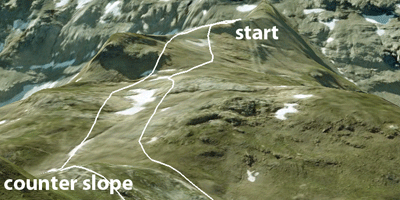Force Diagrams on Skis
At the Wearable Computing Lab at the Swiss Federal Institute of Technology in Zurich, researchers study data from sensors strapped to swimmers, runners, and rowers to help athletes perfect their performance. Now, two scientists at the lab, Thomas Holleczek and Gerhard Tröster, have turned their digital data collection toward the problem of sports safety. In a paper in Physical Review E, they compare simulations that predict which parts of a ski slope will have the highest speed and traffic—two factors related to accidents—with GPS data from 21 skiers descending slopes in the Swiss Alps.
Pedestrian models, such as those that predict how people in a crowded room exit in an emergency, account for the way humans respond to their surroundings with “social forces.” Skiers, for example, are repelled from one another and the side of the slopes, but feel an attraction to the bottom of the hill. In their simulations, which treat skiers as simple, massive particles, Holleczek and Tröster include these effective forces to determine which way a skier will turn, but calculate real forces (gravity, friction) to determine how the skiers accelerate.
The researchers simulated the trajectory, average speed, and number of turns of 600 skiers coming down the Graustock and Jochstock ski slopes at various points along the way. Compared with real skiers, the skiing particles are somewhat faster and streamlined along the center of the slope, which Holleczek and Tröster believe may be because real skiers face changes in friction from varying snow conditions, and make a greater number of turns. But their simulations do predict the zones with the highest speed and traffic, and could help engineers design safer slopes. – Jessica Thomas





